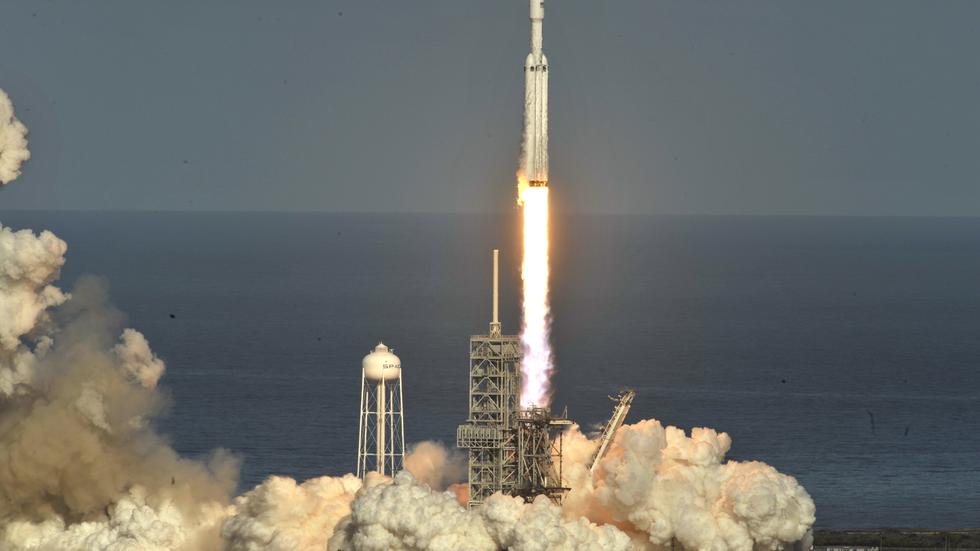John Yang: And finally tonight, we simply can't leave without a longer look at today's liftoff of a huge new rocket from SpaceX.
Crowd: Three, two, one.
John Yang: The world's most powerful rocket, the Falcon Heavy, took off from Kennedy Space Center in Florida. That's where NASA has long launched spacecraft. But, today, it was from the private company started by Elon Musk. At least two million people watched it on the company's livestream on YouTube. Our own science correspondent and resident space expert is here, Miles O'Brien. And it's the focus of our weekly segment on the Leading Edge of science and technology. Miles, welcome. Let's get the serious stuff out of the way. What is the goal of this effort?
Miles O'Brien: Well, Elon Musk wants to go to Mars and colonize Mars. That's the top-line goal. And this is one of the big, important steps along the way. But part of getting to Mars and making that a practical idea is making it more easy to get to space. And this is a lot cheaper. It's a fraction of the cost of anything NASA has built. We used to say in the shuttle days, it was about $10,000 a pound for any pound of anything you put into space. Elon Musk is down around $1,000 a pound. So, we're talking about an order of magnitude improvement on cost, and that has to do with the reusability of these boosters.
John Yang: So these boosters actually landed, re-landed after the liftoff.
Miles O'Brien: It was quite a sight. Two of them made it back. And they landed in perfect synchronicity. It almost looked like animation. And it was really rather spectacular. But those are fully reusable boosters. The shuttle tried to do reusability, but because of a lot of compromises in budgets along the way, it was only partially usable, and ultimately a very expensive craft to fly.
John Yang: And Elon Musk, being the showman that he is, what is he using for a payload?
Miles O'Brien: If NASA were doing this, they probably would have put in ballast, which would have been a bunch of bricks or concrete or something for weight. He put in a Tesla Roadster, which he actually drove, used, with a dummy sitting in the seat with his arm on the window. And on the screen on the Tesla, it says, "Don't panic," David Bowie playing, of course. Now, you have got to appreciate the cross-marketing, number one, Tesla, of course, his company as well, and, number two, just the good, plain fun of it.
John Yang: Absolutely. Now, you have covered the space program for a long, long time. What was it like for you to watch this today?
Miles O'Brien: John, it caught me by surprise, as obviously I wasn't there. I wish I had been there, couldn't get there. But just watching it, I really got emotional. I miss that event, seeing the shuttles launch from those launchpads. That launchpad was where Apollo 11 launched from. Lots of history there. And there's something very moving and emotional about it. I got into covering space because it's one of the few events that binds us all together in an uplifting way. We can think of a lot of things that bring us together and bring our focus together in a negative way, but space has a way of literally and figuratively taking us above the horizon.
John Yang: And the beaches and the stands of the Kennedy Space Center is filled with spectators.

Miles O'Brien: It was reminiscent of the old Moonshots or some of the more celebrated shuttle missions. I'm thinking of the John Glenn flight in 1998, STS-95 on Discovery, where there was a huge amount of people on the beaches, the hotels sold out, and the enthusiasm. And then, of course, the enthusiasm of these young people at mission control in Hawthorne, California, for SpaceX, 20-somethings. And it reminded me that we got to the moon on the backs and through the brains of 20-somethings. It's just a new generation. It's their grand kids. And they have taken the torch. They're carrying the torch and, hopefully, taking us to Mars.
John Yang: And Elon Musk has already booked a commercial flight with this?
Miles O'Brien: Two unnamed people apparently will do an Apollo 8-style mission, that is to say, a lap around the moon, using the Falcon Heavy as a way to get them there. So stay tuned for that. I can tell you it's not me. But I'm available if spot number three comes up.
John Yang: And there was — people may not know this, but there was a journalist in space program, and you were supposed to be a part of it, or may have been part of it.
Miles O'Brien: In my days at CNN, we worked out a deal for me to fly on the shuttle to the International Space Station. Unfortunately, we lost Columbia right about the time we were going to announce that, and that was the end of that. So it's a big long-held dream of mine to have reported from space. I'm tan, I'm rested, I'm ready. That's all I can say.
John Yang: So, Elon Musk, if you're looking for the third, here he is. And for a fourth, I will carry your notebook.
Miles O'Brien: I'm in, brother. Let's go.
John Yang: Great.
John Yang: Miles O'Brien, thanks a lot.
Miles O'Brien: You're welcome, John.
John Yang: And if you can't get enough on NewsHour online right now, you can watch the full rocket launch.













